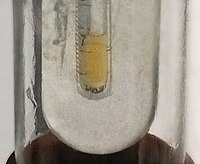
Photo from wikipedia
The use of iodine-131 S values based on reference computational phantoms with fixed thyroid model may lead to significant dosimetric errors in patients who may have different thyroid location from the… Click to show full abstract
The use of iodine-131 S values based on reference computational phantoms with fixed thyroid model may lead to significant dosimetric errors in patients who may have different thyroid location from the reference phantoms. In the present study, we investigated individual thyroid location variation by examining the computed tomography image sets of 40 adult male and female patients. Subsequently, the thyroid location of the adult male and female mesh-type reference phantoms of the International Commission on Radiological Protection (ICRP) was adjusted to match each the highest, mean and the lowest locations of the thyroid observed in this dataset. The thyroid-adjusted phantoms were implemented into the Geant4 Monte Carlo code to calculate thyroid location-dependent iodine-131 S values (rT ← thyroid) for a total of 30 target regions. The maximum variation among the observed thyroid locations was 39 mm and 36 mm for male and female patients, respectively. The mean thyroid locations of both male and female patients showed a good agreement with the ICRP reference phantoms. The thyroid location-dependent Iodine-131 S values were significantly different from the reference phantoms for most target regions by up to a factor of 3. The use of thyroid location-dependent S values in dose reconstructions should help quantify the dosimetric uncertainty in epidemiologic investigations of patients receiving iodine-131 therapy for hyperthyroidism and thyroid cancer.
Journal Title: Radiation protection dosimetry
Year Published: 2020
Link to full text (if available)
Share on Social Media: Sign Up to like & get
recommendations!